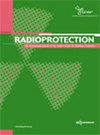Three-dimensional conformal radiotherapy breast cancer planning: An evaluation study comparing two techniques using homemade phantom
IF 1.8
4区 医学
Q4 ENVIRONMENTAL SCIENCES
引用次数: 0
Abstract
Anthropomorphic phantoms, which can provide equivalent human tissue densities, are one of the best solutions for verifying the quality of radiotherapy treatment plans produced by treatment planning systems. The goal of this work was to develop and fabricate a breast phantom to estimate radiation doses to the breast, lung, and surface using radiochromic films (EBT3) for basically two techniques of three-dimensional conformal radiotherapy (3D-CRT) treatment planning. Thirty-two acrylic slices were used to construct the phantom. Cork and Teflon were used to mimic the lung and bone, respectively. Four slots were drilled for dosimetry purposes to allow access to the areas of ionization chamber installation. Both wedged and open of two tangential beams techniques were applied. With a mean deviation of 1.02 ± 1.1, the variation between estimated point doses and measurements using the three ionization chambers ranged from 2.9 to 1.4%. Using 0, 5 and 10 mm boluses, the mean percentage doses on the target surface were 54.7, 88.6 and 91.7% of the prescribed dose (PD), respectively. The homemade phantom was appropriate for conducting quality control (QC) tests for 3D-CRT planning techniques for breast radiotherapy.三维适形放疗乳腺癌计划:两种自制假体技术的比较评价研究
拟人幻影可以提供等效的人体组织密度,是验证治疗计划系统产生的放射治疗计划质量的最佳解决方案之一。这项工作的目的是开发和制造乳房假体,以估计乳房,肺部和表面的辐射剂量,使用放射显色膜(EBT3)用于基本两种三维适形放疗(3D-CRT)治疗计划的技术。使用32片丙烯酸片构建假体。软木和特氟龙分别用来模拟肺和骨。钻了四个槽用于剂量测定,以便进入电离室安装区域。两种切向梁均采用楔形和开式两种技术。估计的点剂量与使用三个电离室的测量值之间的平均偏差为1.02±1.1,变化范围为2.9至1.4%。使用0、5和10 mm丸剂时,靶表面的平均百分比分别为规定剂量(PD)的54.7、88.6和91.7%。自制假体适用于乳腺放射治疗3D-CRT计划技术的质量控制(QC)测试。
本文章由计算机程序翻译,如有差异,请以英文原文为准。
求助全文
约1分钟内获得全文
求助全文
来源期刊

Radioprotection
ENVIRONMENTAL SCIENCES-PUBLIC, ENVIRONMENTAL & OCCUPATIONAL HEALTH
CiteScore
3.30
自引率
54.50%
发文量
35
审稿时长
>12 weeks
期刊介绍:
Radioprotection publishes articles on all aspects of radiological protection, including non-ionising as well as ionising radiations. Fields of interest range from research, development and theory to operational matters, education and training. The very wide spectrum of its topics includes (theoretical and practical aspects): dosimetry, instrument development, specialized measuring techniques, epidemiology, biological effects (in vivo and in vitro) and risk and environmental impact assessments.
 求助内容:
求助内容: 应助结果提醒方式:
应助结果提醒方式:


